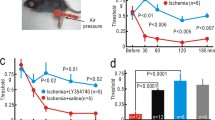Abstract
In anesthetized dogs with chronically implanted cortical electrodes somatic sensory-evoked potentials (SEPs) were produced by electrical stimulation at neural, muscular or cutaneous sites of the contralateral hind leg. Stimulation of the tibial nerve at the calcaneus or of the short flexor muscles of the hind paw caused SEPs having characteristics following activation of rapidly conducting afferents from muscle spindles. Stimulation of the glabrous skin of the central pad resulted in SEPs arriving after a more protracted latency evidently related to activation of afferents from Merkel cells, Krause and Pacinian corpuscles known to be located at these sites. Stimulation of the hairy skin from the dorsal surface of the hindpaw produced a further type of SEP presumably resulting from activation of afferents from receptors of tylotrich hair follicles.
Vitamin B6-induced neuropathy involves the selective degeneration of the largest neurons in the spinal ganglia and of associated long peripheral and central neurites performing rapid impulse transmission. In the course of vitamin B6 neuropathy the relatively slow impulse transmission following stimulation of the central pad was more severely impaired than the faster one after activation of afferents from muscle spindles or receptors from hair follicles. This allows us to conclude that in the dog afferents from the glabrous skin of the central pad conduct centrally via the dorsal columns, susceptible to vitamin B6 intoxication, while muscle and hair receptor afferents ascend in the dorsal spinocerebellar and spinocervical tract, respectively, which are vitamin B6 resistant.
Similar content being viewed by others
References
S. Landgren andH. Silfvenius,Nucleus Z, the medullary relay in the projection path to the cerebral cortex of group I muscle afferents from cat's hind limb, J. Physiol., Lond.218, 551–571 (1971).
S.T. Kital, H. Ha andF. Morin,Lateral cervical nucleus of the dog: anatomical and microelectrode studies, Am. J. Physiol.209, 307–311 (1965).
A.G. Brown, Ascending and long spinal pathways: dorsal columns, spinocervical tract and spinothalamic tract. InHandbook of Sensory Physiology: Somatosensory System, vol. II (Ed.A. Iggo), Springer Verlag, Berlin 1973.
A.G. Brown,Organization in the Spinal Cord. The Anatomy and Physiology of Identified Neurones, Springer Verlag, Berlin 1981.
U. Norrsell,The spinal afferent pathways of conditioned reflexes to cutaneous stimuli in the dog, Exp. Brain Res.2, 269–282 (1966).
P.R. Burgess andE.R. Perl, Cutaneous mechanoreceptors and nociceptors. InHandbook of Sensory Physiology: Somatosensory System vol. II (Ed.A. Iggo), Springer Verlag, Berlin 1973.
U. Norrsell andE.R. Wolpow,An evoked potential study of different pathways from the hindlimb to the somatosensory areas in the cat, Acta physiol. Scand.66, 19–33 (1966).
A. Taub andP.O. Bishop,The spinocervical tract: dorsal column linkage, conduction velocity, primary afferent spectrum, Exp. Neurol.13, 1–21 (1965).
G. Krinke, H.H. Schaumburg, P.S. Spencer, J. Suter, P. Thomann andR. Hess Pyridoxin megavitaminosis produces degeneration of peripheral sensory neurons (sensory neuronopathy) in the dog, Neurotoxicology2, 13–24 (1981).
U. Schaeppi andG. Krinke,Pyridoxine neuropathy: correlation of functional tests and neuropathology in beagle dogs treated with large doses of vitamin B6, Agents and Actions12, 575–582 (1982).
Environmental Protection Agency Washington, DC. Pesticide Assessment Guidelines, Subdivision F, Hazard evaluation: Humans and domestic animals. U.S. Department of Commerce, Nov. 1982, Microinfo Ltd. P.O. Box 3, Newman Lane, Alton, Hants, GU34 2PG, England.
Organization for Economic Co-operation and Development: OECD Guidelines for Testing of Chemicals 1981, OECD 2 Rue Andre Pascal 75775 Paris, Cedex 16, France.
U. Schaeppi, M. Teste andU. Siegenthaler,Sensory and motor maximum nerve conduction velocity in the peripheral and central nervous system of the beagle dog, Agents and Actions12, 566–574 (1982).
T. Pinto Hamuy, R.B. Bromiley andC.N. Woolsey,Somatic afferent areas I and II of the dog's cerebral cortex, Am. J. Physiol163, 719–720 (1950).
C.N. Woolsey, Organization of somatic sensory and motor areas of the cerebral cortex. InBiological and Biochemical Basis of Behaviour (Eds.H.F. Harlow andC.N. Woolsey), University of Wisconsin Press 1965.
U. Schaeppi, The neurologic examination of beagle dogs in toxicity. InLectures in Toxicology, no. 18 (Ed.G. Zbinden), Pergamon Press, Oxford 1982.
D. Burke, S.C. Ganndevia, B. McKeon andN.F. Skuse,Interactions between cutaneous and muscle afferent projections to cerebral cortex in man, Electroenceph. clin. Neurophysiol.53, 349–360 (1982).
G. Werner andB.L. Whitsel, Functional organization of the somatosensory cortex. InHandbook of Sensory Physiology, vol. II (Ed.A. Iggo), Springer Verlag, Berlin 1973.
U. Schaeppi andG. Krinke,Prolonged exposure to trimethylphosphate induces sensory motor neuropathy in the dog, Neurobehav. Toxicol. and Teratol.6, 39–50 (1984).
M. Levitt andJ. Levitt,Sensory hind-limb representation in the SmI cortex of the cat after spinal tractotomies, Exp. Neurol.22, 276–302 (1968).
M. Schiepatti andA. Ducati Effects of stimulus intensity, cervical cord tractotomies and cerebellectomy on somatosensory evoked potentials from skin and muscle afferents of cat hind limb, Electroenceph. clin. Neurophysiol.51, 363–372 (1981).
H. Schaumburg, J. Kaplan, A.Windebank, N. Vick, S. Rasmus, D. Pleasure andM.J. Brown,Sensory neuropathy from pyridoxine abuse. A new megavitamin syndrome, New Engl. J. Med.309, 445–448 (1983).
Author information
Authors and Affiliations
Rights and permissions
About this article
Cite this article
Schaeppi, U., Krinke, G. Differential vulnerability of 3 rapidly conducting somato-sensory pathways in the dog with vitamin B6 neuropathy. Agents and Actions 16, 567–579 (1985). https://doi.org/10.1007/BF01983664
Received:
Accepted:
Issue Date:
DOI: https://doi.org/10.1007/BF01983664




